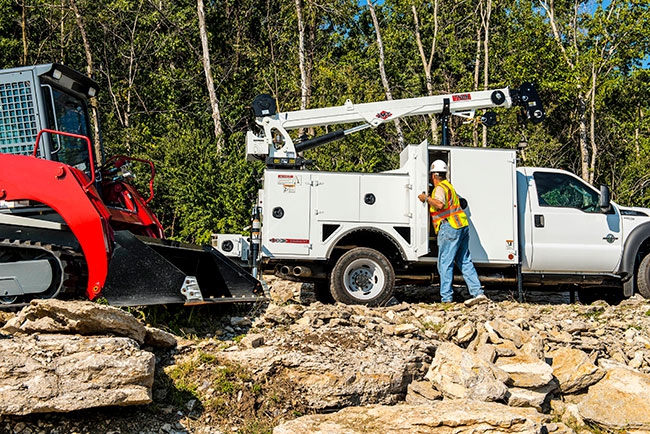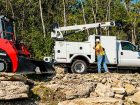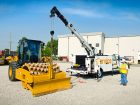
Service on wheels
By Canadian Rental Service
ProductsProductivity and profitability are always shadowed by the threat of equipment downtime. That’s why service trucks are the treasured assets of equipment support. Rental fleet managers can depend on these trucks — field mechanic, tire repair, lubrication or combination rigs — to efficiently maintain and repair rental equipment that generates revenue.
 The service truck you specify will depend on what you need it to do. Possible configurations include field mechanics Productivity and profitability are always shadowed by the threat of equipment downtime.
The service truck you specify will depend on what you need it to do. Possible configurations include field mechanics Productivity and profitability are always shadowed by the threat of equipment downtime.Service trucks keep rental customers up and running and their projects moving along, assisting equipment with repairs, preventive maintenance, tire repair or replacement and fueling. Accordingly, rental fleet managers should place great importance on service-truck selection.
Getting the most out of your service truck starts during the specification process. Neglecting to properly specify the truck is a significant — and potentially costly — mistake. A truck that is too large for your rental equipment will not provide maximum return on investment, while a truck that is too small could mean needs go unmet and operation costs soar. Rental fleet managers should work with a mechanics truck distributor to design the right truck for their operation.
Don’t leave it all up to the distributor, though. Prepare yourself before entering the buying process with this essential guide to service-truck selection, with advice on what to look for and what common mistakes to avoid when picking out your truck.
1. Identify application needs
As rental fleet managers begin their search for the perfect service truck, they should first identify the specific needs for the application, including payload, lifting, air supply, welding, lubrication and storage. Additionally, managers should keep in mind their cost of operation and intended replacement cycle when specifying a truck.
It’s important to remember that service-truck specifications are highly interdependent, no matter if it is a mechanics truck, a tire-service truck or a lubrication vehicle. For example, when specifying a field-service mechanics truck, lifting needs dictate crane size, which governs the size of the body. Crane size, body size and required payload combine to decide the size of the chassis. The tools needed on the truck, coupled with other air needs,will determine whether a rotary-screw or reciprocating air compressor is added.
These mutually dependent specifications call for complete systems integration, so be sure that the service-truck manufacturer you choose can offer these capabilities.
2. Optimize your chassis
When specifying a chassis for a service truck, lube truck or tire-repair truck, it is important to ensure clear frame behind the cab so there is no restriction on the amount of usable space on the chassis frame. Additionally, it is recommended that you purchase a chassis with a frame section modulus and RBM (resistance to bending moment) ratings that comply with equipment manufacturers’ minimum chassis requirements.
A crucial component for all service trucks, no matter the type, is sufficient GVWR (gross vehicle weight rating) to maintain road legality when all payload is accounted for. When working with a lubrication truck or a mechanics truck with lube capability, this should be calculated with the product tanks completely full.
3. Properly calculate weight distribution
Proper weight distribution calculation is paramount to avoiding overloading, which can incur fines from transportation authorities. To ensure that a service vehicle is road legal, a rental fleet manager should consider the weight of the truck chassis, the body, the crane and all product tanks, if applicable.
Completely loaded product tanks are concentrated and relatively stable during off-road operation. However, liquids in partially filled tanks will surge forward and backward when the truck is in motion, mandating heavier suspension ratings to maintain vehicle stability while driving.
4. Find a good foundation
The body of a mechanics truck doubles as a means of carrying payload and as the foundation that supports the crane, so body-structure selection depends heavily on the size of the crane needed for the application.
Lubrication bodies come in two primary styles, open and enclosed, and their sizes depend on the amount of products required for the rental applications. Both styles provide access to all pumping equipment and product tanks, while enclosed units help keep products warm, provide protection from weather and offer added security.
Avoid the common pitfall of choosing a service-truck body structure based on load characteristics.
5. Ensure you have sufficient electrical and hydraulic systems
Advances in wiring have vastly increased reliability while making it easier to find and solve electrical problems. Automotive-style wiring harnessing and on-board circuit protection will provide greater system longevity and minimize troubleshooting time.
Hydraulic systems are constantly responding to market needs and are being continually improved upon. On-board, auxiliary hydraulic systems driven by a separate engine are coming of age to provide hydraulic power without the use of the prime mover, the chassis engine. Filtration is a key element for hydraulic needs, so make sure filters are accessible for maintenance purposes.
6. Be picky about tank material
Contamination control continues to rank high on lists of concerns for rental fleet managers, and the material for product tanks has evolved to help meet these needs. Polyethylene tanks provide the dual benefit of weight reduction and contamination control. These tanks are not susceptible to rusting or weld contamination, thus keeping stored product cleaner. As an added bonus, these tanks naturally flex, so there is no need for baffles or traditional mounting.
All tanks should come supplied with proper fill capabilities, filtering, breathers and fluid-level visibility.
7. Quiz yourself before you choose a crane
One of the most important steps in specifying a mechanics truck is determining how much you need to lift, and how often. One mistake rental customers commonly make is underestimating the weight of the load to be lifted.
There are two main questions all rental fleet managers must ask themselves before they choose a crane for an application: What do I need to lift at what distance? And, how often will the crane be used?
Capacity needs and duty cycle will guide selection from three options: electric telescopic cranes, hydraulic telescopic cranes and articulating cranes.
Electric telescopic cranes
If the crane duty cycle is intermittent, an electric telescopic crane might be the best solution. Typically, electric cranes feature a maximum lifting capacity of between 2,000 and 6,000 pounds. If you lift anything larger than 6,000 pounds, a hydraulic crane may be necessary.
Hydraulic telescopic cranes
If the crane will be used regularly, a hydraulic telescopic crane is for you. The most common choices for mechanics trucks are body-mounted hydraulic telescopic cranes, which offer a wide range of lift and reach capabilities to meet most field-service needs. Hydraulic cranes usually handle jobs that are between 6,000 and 14,000 pounds.
Articulating cranes
If lifting requirements exceed 14,000 pounds, consider utilizing an articulating crane. Articulating cranes deliver more lift and more reach than a body-mounted telescopic crane. While there are many size options with telescopic cranes, there are even more size options with articulating cranes. A crane operator who is used to telescopic cranes will likely pick up articulating-crane operation fairly quickly.
The most important thing to remember when choosing among crane options is to avoid underspecifying your crane in an attempt to reduce acquisition cost. While it may be cheaper in the short term, you will end up paying more in the long run.
Whether you choose a mechanics or lube truck, an articulating or telescopic crane, or an open or enclosed truck body, your customer’s productivity will be enhanced and downtime reduced if you follow these best practices. With an optimized service truck that is properly specified to your needs, you can keep your rental fleets working efficiently and get your equipment back up and running as soon as possible. Because if your customers aren’t able to use the equipment they rented, then you aren’t making money.
Print this page



Leave a Reply